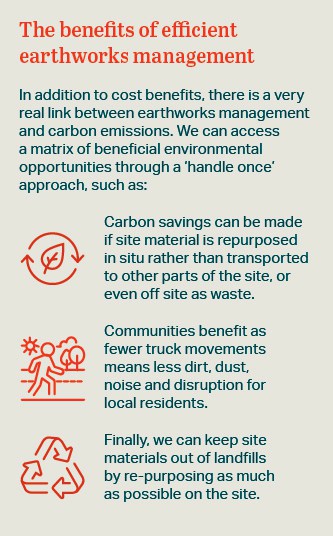Ground control: how to realise the cost savings and carbon benefits of better earthworks management
Global best practice shows that efficient earthworks management can lead to a reduction in carbon, cost as well as the associated environmental impact on local communities. Yet the full benefits of new technologies and circular economy processes have yet to be fully realised within the UK. Ground engineering expert Niall Corney advocates the need for a more proactive approach.
The reduction of waste through circular economy principles and resource efficiency has a key role to play in reducing the environmental impact of major road and rail projects. However, uptake of new earthworks assessment and management techniques and processes within the UK is arguably slow. There’s a very real risk that potential opportunities to reduce cost and carbon may be lost if our industry continues to take a traditional approach to earthworks management.
This article draws from global best practice and specialist geosystem knowledge to suggest alternative ways that clients and contractors can take ownership of ground conditions – even unforeseen ones – to reduce costs and carbon, and to benefit local communities.
The potential of geosystems
There are many ways to reuse site-won materials ranging from primary fills for earthworks structures through to those needing modification or improvement to allow their reuse in a meaningful way. We use the term ‘geosystems’ to include any composite solution to ground engineering challenges, which are more sustainable and cost efficient than traditional alternatives. Geosystems cover applications from ground improvement techniques such as mechanical or chemical soil stabilisation through to reinforced soil applications such as abutment thrust relief walls or geotextile encased columns.
 While geotechnical engineers may possess the tools to manage unforeseen ground conditions in a sustainable way, they are often hindered from using these techniques as the prevailing site conditions are perceived by many as not being appropriate – forming barriers to their use.
While geotechnical engineers may possess the tools to manage unforeseen ground conditions in a sustainable way, they are often hindered from using these techniques as the prevailing site conditions are perceived by many as not being appropriate – forming barriers to their use.
In the UK, a traditional, risk-averse, highly conservative approach to ground engineering prevails, where (carbon intensive) methods are often chosen over globally employed methodologies, which are often mistakenly labeled ‘innovative’.
However green shoots are emerging from some client organisations who appear to recognise the potential benefits of adopting new techniques. A recent study from HS2 in conjunction with the Infrastructure Industry Innovation Partnership (i3P) identified potential annual savings of £300 million within earthworks alone from 26 key opportunities within the UK.
Thinking differently about earthworks: three steps to better outcomes
Here are three ways to think differently about earthworks to encourage innovative approaches and sustainable solutions to ground engineering challenges.
1/ Learn from global best practice. When using geotechnical solutions which are not commonly used in the UK – often mistakenly labeled ‘innovative’ – we can use our global technical practice network to identify international expertise in design and construction of similar structures and processes.
Example: We used two reticulated micro-pile retaining walls to protect Crystal Palace Subway, a Grade II listed structure, saving in whole life costs. As micro-pile reticulated retaining walls were not commonly used in the UK at the time, we consulted with colleagues in US and Australia who provided valuable references to design methodology and detailing for construction.
2/ Adopt an agile approach to material treatment and performance specifications. A rigid, prescriptive earthworks specification will often hinder the uptake of ‘innovative’ approaches; essentially demanding the default adoption of traditional ‘proven’ techniques. It is preferable to take a more pragmatic approach based on end product performance and durability to ensure the engineering performance of the materials in question.
Example: The use of lime / cement stabilisation with cohesive materials, coupled with the use of a single source Ground Granulated Blast-furnace Slag (GGBS) component will often achieve the desired end product strengths – albeit after extensive laboratory testing and site verification trials. However, where single source additive by-products (such as GGBS) are concerned, it is important to build resilience into any laboratory validation process to ensure a depth of alternatives is understood and available should the single source product supply be compromised.
3/ Invest in ground investigations. While ground engineers possess the tools to deal with all unforeseen ground conditions, alternative low carbon solutions can also be identified and developed in parallel early in the design phase. By doing so, we can have a suite of optimised alternatives ready for any unforeseen conditions which present themselves without the need to adopt over-conservative ‘belt and braces’ responses to the problem in question.
Example: the non-identification of large voids within karst topography during construction often elicits the default reaction to grout and backfill the voids, a time-consuming and expensive process. Having a set of pre-calculated geosynthetic-based void-spanning solutions provides a rapid and effective alternative.
There are many ways we can improve our approach to earthworks management for the wider benefit: by embracing more pragmatism in our design and management processes; building in resilience; and questioning the standard options so prevalent in our industry.
Ultimately however, there is no substitute for a comprehensive ground investigation: as it’s the tool by which we can design out excess conservatism and ensure sustainable, lower cost solutions are adopted at the outset.






